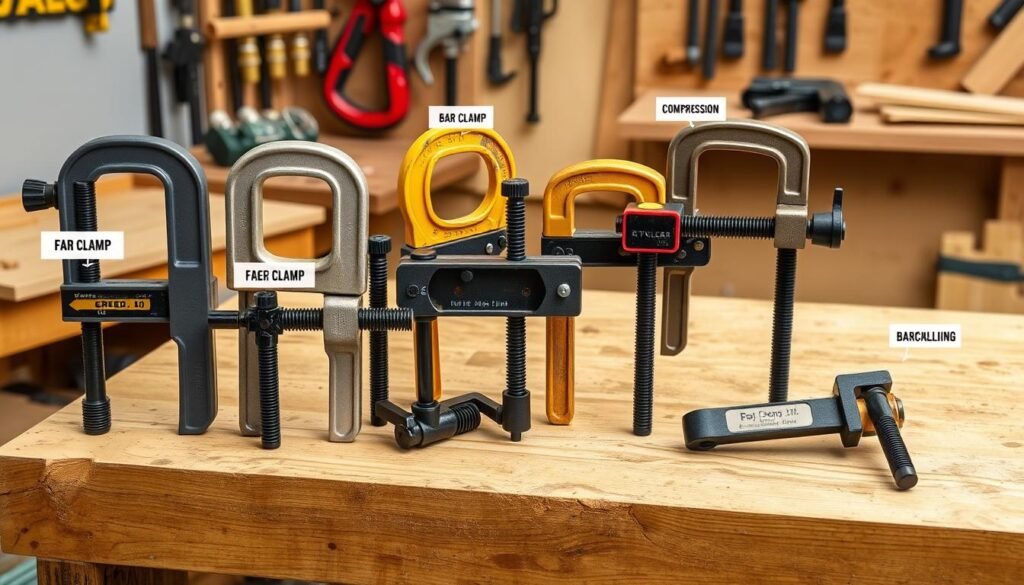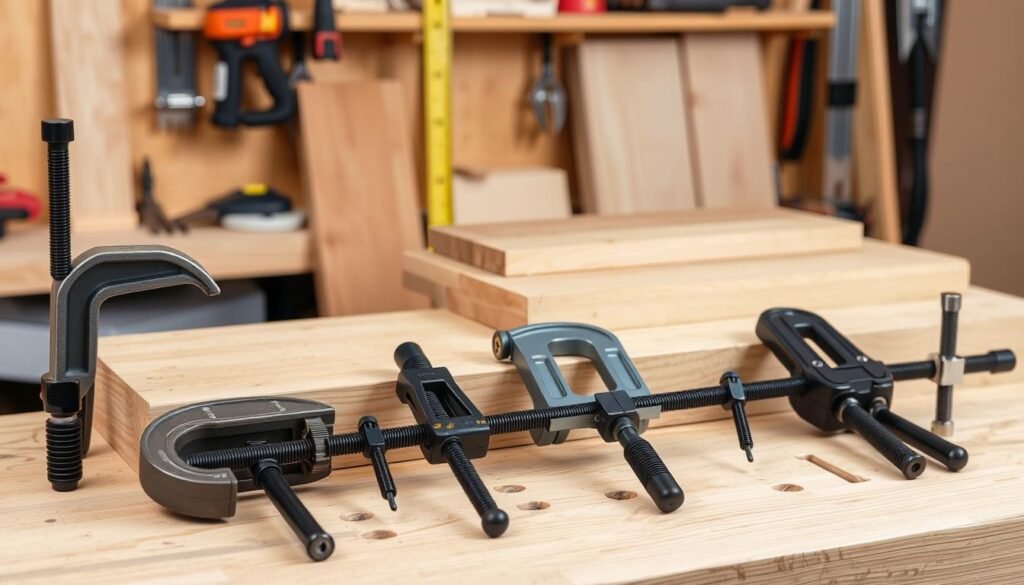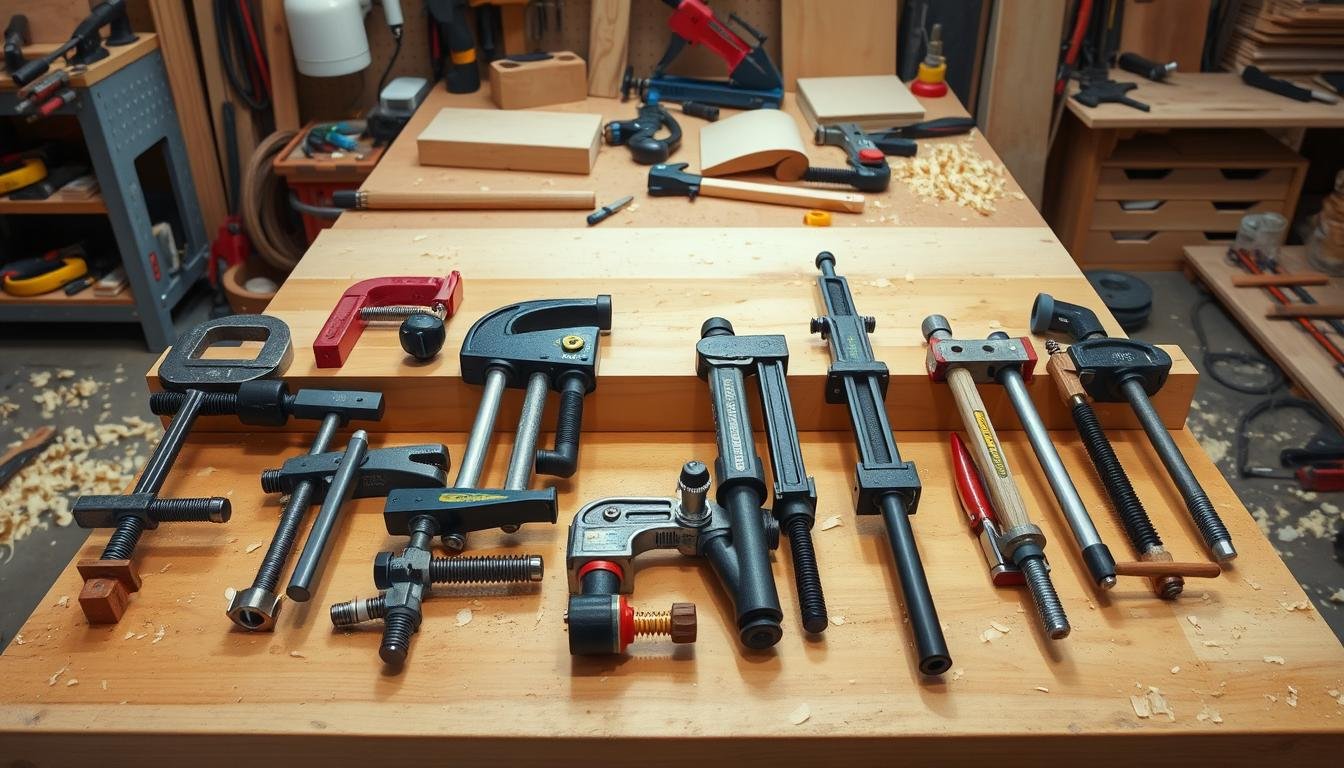In the woodworking world, the F clamp is key. It’s known for its power to hold pieces together well. But it goes by many names, showing how it can do different things. Learning these names lets you know more about woodworking clamps. This helps you talk about them in many places and situations. Whether you call it a bar clamp or a sliding arm clamp, knowing these terms is important for anyone who loves woodworking.
Key Takeaways
- The F clamp is integral to woodworking projects.
- Various names are used interchangeably for F clamps.
- Understanding terminology enhances communication among woodworkers.
- F clamps are classified as versatile clamping tools.
- Regional differences exist in the names used for clamps.
Introduction to F Clamps
F clamps are key for woodworking tasks. They have a frame shaped like an “F”, which helps apply pressure well. Their design lets woodworkers hold materials tightly, mainly for gluing and assembly jobs.
The core of F clamps is the screw part that adjusts the pressure. This feature is perfect for applying just the right amount of force. These clamps are made from strong materials like steel and aluminum, making them durable and dependable.
Using F clamps makes woodworking more efficient and improves project quality. They’re easy to adjust, making them essential for all woodworkers. To learn more, visit clamps and clamping for more info.
Understanding Clamping Tools
Clamping tools are vital in woodworking. They keep materials in place during assembly, gluing, or cutting. There are many kinds, like bar clamps, corner clamps, and quick clamps. They are known for being versatile and effective.
Using the right clamps can greatly improve your work’s quality. It’s crucial to spread pressure evenly. Otherwise, you might harm your material or mess up its alignment. With the right clamping skills, woodworkers can excel, whether fixing something small or creating complex furniture.
Different clamps suit different jobs. Bar clamps work well for big projects. Corner clamps keep joints square. For quick tasks, quick clamps are best. Choosing the right clamp boosts your efficiency in woodworking.
| Type of Clamp | Best Used For | Advantages |
|---|---|---|
| Bar Clamps | Large assemblies | Strong holding power, adjustable length |
| Corner Clamps | Maintaining square joints | Prevents shifting, easy alignment |
| Quick Clamps | Rapid tasks | Fast application, lightweight |
Getting to know and use these tools shows a woodworker’s commitment. Properly using clamps is often key to a project’s success.
Other Names for F Clamp
F clamps have many names in the woodworking world. These various terms are vital for good communication among woodworkers. Let’s look at the common names and see how they vary by region.
Common Variations and Terminology
Woodworkers call F clamps by different names. Each name reflects a specific design or use. Here are some common terms:
- Bar clamp: Also known as F clamp, these have a long steel bar. They are famous for easy adjustments.
- Face clamp: These clamps ensure even pressure on flat surfaces. They are perfect for working on panels.
- Pony clamp: Named after a brand, they are great for small jobs. They are liked for their small size.
The names show the variety and special features of clamps. This helps woodworkers choose the best tool for their work.
Regional Differences in Terminology
Different areas have their own names for F clamps. For instance:
| Region | Common Terms Used |
|---|---|
| East Coast | Bar clamp, F clamp |
| West Coast | Face clamp, Pony clamp |
| Midwest | F clamp, Board clamp |
Knowing these regional names makes teamwork and understanding better in woodworking. It ensures everyone can talk about tools clearly, no matter where they are.

Popular Types of Clamps in Woodworking
Woodworking needs the right tools for precision and stability. Framing clamps and grip clamps are two popular types. Each has its own role, essential for woodworkers enhancing their projects.
Framing Clamps and Their Uses
Framing clamps help hold large wood pieces together when assembling. They apply even pressure across joints, key in making furniture frames or structures. Their design allows reaching into tight spots to ensure a strong bond.
For big projects, their ability to align and stabilize wood pieces is a top reason professionals and hobbyists prefer them.
Grip Clamps: An Essential Tool
Grip clamps stand out for their simple yet effective use in woodworking. They’re lightweight, so they’re easy to handle. They securely hold pieces without harming the surface, perfect for delicate projects.
The quick adjustment and repositioning make grip clamps boost efficiency during work.
Quick Clamps: Speed and Efficiency
Quick clamps are key for woodworkers, offering fast clamping solutions to boost productivity. Their design often allows one-handed use, simplifying adjustments and securing tasks. This boosts efficiency in woodworking, letting users focus more on their projects without hassle.
Adding quick clamps to your tools offers real benefits. They’re great for many tasks, like putting together furniture or intricate woodwork. Many woodworkers value the time these clamps save, ensuring a smoother process.
When looking at quick clamps, check their locking features and how they adjust. Some have strong clamping force, others are lighter and easy to handle. Knowing about different quick clamps helps choose the right one for any project.
| Feature | Quick Clamps | Traditional Clamps |
|---|---|---|
| Operation | One-handed | Two-handed |
| Clamping Speed | Fast | Medium |
| Weight | Lightweight | Heavier |
| Typical Usage | Quick adjustments | Heavy-duty projects |
Learning about quick clamps shows their clear benefits in woodworking. Using these tools can make projects better, with more efficiency and ease.
Choosing the Right Clamp for Your Project
Choosing the best clamp can greatly impact the outcome of your woodworking work. Each project needs a specific type of clamp, considering different factors. Knowing these factors helps make choosing easier, so you always pick the right clamp for your tasks.
Factors to Consider in Clamp Selection
Think about these things when picking a clamp:
- Material: Clamps are made for different materials like wood, metal, or plastic. Make sure the clamp fits your project’s material.
- Size of Workpiece: Your project’s size affects the type of clamp needed. Bigger projects need larger clamps.
- Type of Joint: Different clamps work better for different kinds of joints. For example, corner joints and butt joints might need various clamps.
- Pressure Requirements: Some projects need more clamping force than others. Think about how much pressure your project needs.
Comparison of Different Clamp Types
Comparing clamps shows their benefits and drawbacks for woodworking:
| Clamp Type | Best Use | Advantages | Limitations |
|---|---|---|---|
| F Clamp | General purpose | Strong and versatile | May require more space |
| Pipe Clamp | Large projects | Adjustable length | Heavier and less portable |
| Bar Clamp | Speedy adjustments | Quick to operate | Less pressure than F clamps |
| Spring Clamp | Light-duty tasks | Easy to use | Not suitable for heavy-duty applications |

Usage Tips for F Clamps and Alternatives
F clamps are vital in woodworking for a stable hold. To use them well and make fewer mistakes, follow these tips. They ensure your work is of high quality.
- Prevent Marring: Place soft padding like scrap wood or rubber pads on the clamp jaws. This keeps your workpieces safe from damage.
- Achieve Even Pressure: It’s important that the pressure is the same all over. Tighten the clamps bit by bit. This makes the force spread out evenly on the material.
- Arranging Multiple Clamps: For big projects, use many clamps in a smart way. Put them evenly around your work to keep it stable and to avoid bending.
There are also other types of clamps besides F clamps. Quick clamps are fast and simple to use. Pipe clamps work well for big things. Knowing about different clamps helps you get better at woodworking. It makes you more efficient too.
Why F Clamps Are Essential in Woodworking
F clamps are very important in woodworking. They hold materials tight during assembly and when applying glue. They can apply a lot of pressure but won’t harm your work, perfect for different projects.
They fit various shapes and sizes, thanks to their adjustable arms. This lets woodworkers do precise, complex work easily. Experts and beginners alike find F clamps crucial.
F clamps stand out because they’re strong yet easy to use. They help make joints that are both strong and accurate. This is key for making pieces that last. F clamps are valuable for all kinds of woodworking tasks.
Conclusion
F clamps are key for any craftsperson. They offer many names and types, helping enhance your projects. By understanding F clamps and their alternatives, you find the best fit for your needs.
The right clamps are crucial for precision, safety, and effectiveness in woodworking. Whether new or experienced, the right clamps improve your work’s quality. Using a variety of clamps boosts creativity and craftsmanship.
In conclusion, with many clamping tools out there, F clamps stand out. They are adaptable and strong, perfect for any project. They help you work with confidence and precision. So, remember the value of choosing the right clamps for your projects.
















